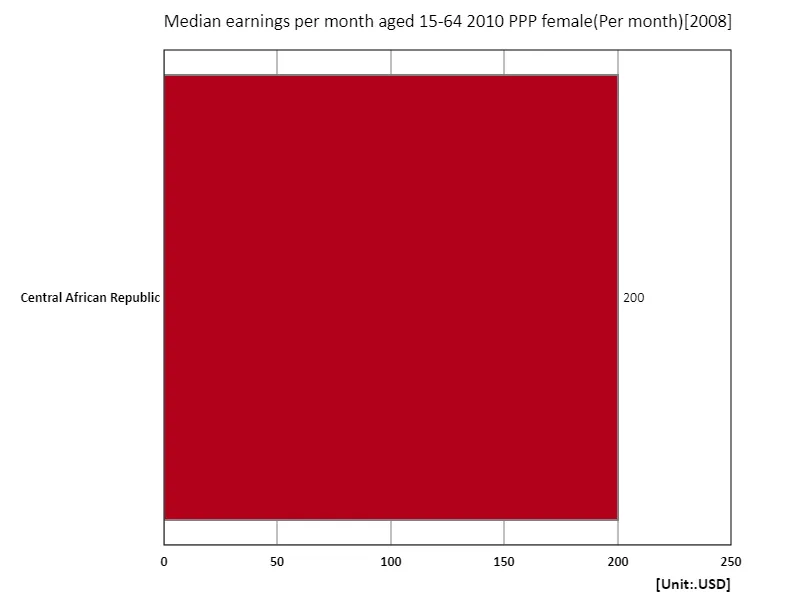- Abstract
- Average monthly income (women, 15-64 years old, 2010 purchasing power parity)
- Average monthly income (women, ages 15-64, 2010 purchasing power parity) (countries around the world)
- Average monthly income (women, 15-64 years old, 2010 purchasing power parity) (nations around the world, latest year)
- Average monthly income (women, 15-64 years old, 2010 purchasing power parity) (region, latest year)
- Reference
Abstract
In recent years, there have been large differences in the average monthly income of women in employment wages around the world from country to country. According to 2020 data, South Africa has the highest value at 445 USD, reflecting some of the economic development on the African continent. In South Africa, an increasing proportion of relatively highly educated women are entering the labour market, especially in urban areas. Meanwhile, wage inequality remains a problem in other regions, with women’s wages still lower than men’s, particularly in developing countries. While employment opportunities for women are increasing as education levels improve and vocational training becomes more extensive, traditional gender roles still play a role and often hold down overall wages. In addition, differences in working conditions and policies also have a significant impact on wages. For example, while developed countries have strong protections for workers’ rights, developing countries tend to have harsh working conditions and low wages. As such, women’s average monthly income is determined by a variety of factors depending on the country and region, and future economic growth and policy trends will require close attention.
Average monthly income (women, 15-64 years old, 2010 purchasing power parity)
Looking back at data from 1991 to 2020, regional variations in women’s average monthly income and economic backgrounds become apparent. In particular, Turkey’s peak of 533 USD in 2004 symbolized the economic growth and increased female participation in the labor market at that time. However, in 2020, that level fell to 154%, indicating Türkiye’s difficult economic situation. A defining feature of many countries during this period is that women’s wages continue to be lower than men’s. Despite widespread education and increased career opportunities, wage disparities persist. Especially during economic crises and recessions, women’s employment tends to be the first to be affected. In addition, because policies and social expectations affect wages, in some countries the working environment is not improved, resulting in low monthly income for women. As such, women’s average monthly income depends on various factors across countries and times, and trends reflect changes in each country’s economy and society. Future challenges include correcting the gender wage gap and working towards sustainable economic growth.


The maximum is 533MUSD[2004] of Turkey, and the current value is about 154μ%
Average monthly income (women, ages 15-64, 2010 purchasing power parity) (countries around the world)
Analysis of women’s average monthly earnings data from 1991 to 2020 reveals significant economic and social changes. In particular, Turkey’s peak of 533 USD in 2004 indicates the country’s economic growth and increasing female labor force participation. However, Turkey’s economy has since become unstable, and by 2020 its growth rate had fallen to 154% of its peak. This likely reflects the fragility of the local economy and the impact of policies. During this period, there were diverse trends in average monthly earnings for women around the world. In many countries, while women’s educational attainment is improving and they are increasingly entering the labor market, the gender wage gap remains persistent. Especially during economic crises and recessions, women tend to be the first to lose jobs, which often leads to reduced wages. Additionally, policy differences and cultural backgrounds also have a significant impact on wages. While developed countries have relatively good working conditions, developing countries often still have harsh working conditions. As such, women’s average monthly income is strongly influenced by each country’s economic situation and social background, and efforts are needed to achieve sustainable growth in the future.


The maximum is 533MUSD[2004] of Turkey, and the current value is about 154μ%
Average monthly income (women, 15-64 years old, 2010 purchasing power parity) (nations around the world, latest year)
According to 2021 data, Thailand recorded the highest average monthly income for women (aged 15-64, 2010 purchasing power parity) at 859 USD, compared to the overall average of 386 USD and a total of 1.54 KUSD. These figures reflect regional economic differences and women’s status in the labour market. Thailand’s high average monthly income is indicative of economic growth and active female participation in the labor market. In particular, it is believed that the spread of education and the improvement of vocational training have expanded employment opportunities for women and contributed to higher wages. However, the overall average monthly salary of 386 USD indicates that wage disparities still exist in many countries. Especially in developing countries, women often receive lower wages than men and face harsh working conditions. In addition, economic insecurity and social mores can prevent women from entering the labour market, which in turn affects wages. During the COVID-19 pandemic, women tend to be affected first, with employment insecurity further negatively impacting wages. As such, the 2021 data shows regional differences in women’s monthly income and changing economic conditions, highlighting the importance of future economic policies and social initiatives to improve women’s wages.


The maximum is 859USD of Thailand, the average is 386USD, and the total is 1.54kUSD
Average monthly income (women, 15-64 years old, 2010 purchasing power parity) (region, latest year)
According to data from 2008, the average monthly income for women (aged 15-64, 2010 purchasing power parity) is very low, with the highest being $200 in the Central African Republic. The figures highlight the stark global wage gap. The overall average and total is also the same 200 USD, indicating that the economic situation of women in certain regions and countries remains extremely vulnerable. Low monthly incomes in the Central African Republic are likely a result of political instability, slow economic development, and a lack of education and vocational training. Women often work in domestic or informal jobs and have limited access to formal employment, meaning their wages are more likely to stagnate. In particular, in the agricultural and service industries, women’s work is valued, but their wages are often minimal. This situation is a trend seen in other developing countries as well, and improving women’s economic status through the spread of education and improvements to working conditions is essential. Social mores and institutional barriers adversely affect women’s employment opportunities and wages, calling for comprehensive policies. Going forward, it will be important to take concrete steps to promote women’s participation in the labor market and eliminate wage disparities.


The maximum is 200USD of Central African Republic, the average is 200USD, and the total is 200USD



Comments